The objectives of the social and communicative development of preschool children are:
- assimilation of norms and values accepted in society, including moral and moral values;
- development of communication and interaction of the child with adults and peers;
- the formation of independence, purposefulness and self-regulation of one’s own actions;
- development of social and emotional intelligence, emotional responsiveness, empathy, formation of readiness for joint activities with peers, formation of a respectful attitude and a sense of belonging to one’s family and to the community of children and adults;
- the formation of positive attitudes towards various types of work and creativity; formation of the foundations of safe behavior in everyday life, society, and nature.
Socio-communicative development is the process of assimilation and further development by an individual of socio-cultural experience necessary for its further inclusion in the system of social relations.
Its relevance is increasing in modern conditions due to the peculiarities of the child’s social environment, in which there is often a lack of good manners, kindness, goodwill, and speech culture in people’s relationships.
Analyzing the problems of modern preschoolers, we can highlight the following typical features:
- despite changes in the world, society and family, preschoolers remain children, they love to play (the content of games has changed, along with role-playing games, children choose computer games, games with modern puzzles, construction sets);
- Significant changes have occurred in the intellectual sphere of children, they have become more informed and inquisitive, they can freely navigate modern technology in adult life, which is facilitated by a rich environment in kindergarten and at home;
- Changes are noted in the moral, social and personal development of children, in their behavior and communication.
The problems of preschool childhood are caused and aggravated, among other things, by the inability and unpreparedness of some families to create conditions for the harmonious socialization of the child.
Communication is one of the most important human needs, the main way of human life and the condition for its development. Only in communication and in relationships with other people can a person feel and understand himself, find his place in the world, socialize, and become a socially valuable person.
Communication is becoming a mega-activity in modern life, i.e. an activity that is basic to all other types of human activity, permeates them and is a condition for their successful implementation. In this regard, the problem of social and communicative development—the development of a child in interaction with the world around him—becomes especially relevant at the present stage.
Opportunities for developing communication skills of children 4-5 years old
Opportunities for developing communication skills of children 4-5 years old
Recognition of the intrinsic value of preschool age and the attitude towards it as a unique period of personality development determined the task of studying the characteristics of the formation of communicative skills in children aged 3–7 years. In developing this issue, pedagogical practice was based on the concept of activity of L.S. Vygotsky, A.N. Leontyev and psychological and pedagogical research by D.B. Elkonina, A.V. Zaporozhets, V.G. Nechaeva, Ya.L. Kolominsky, A.I. Arzhanova, M.I. Lisina, etc.
M.I. Lisina, A.G. Ruzskaya, Z.M. Boguslavskaya, et al. investigated the relationship between the development of communication skills and the mental development of a preschooler and their influence on the overall level of development of activity. The content and nature of communication between preschoolers and adults was studied by Z.M. Boguslavskaya, S.V. Kornitskaya, M.I. Lisina, A.G. Ruzskaya and others, with peers - L.N. Bashlakova, T.I. Erofeeva, A.A. Royak, B.S. Volkov and N.V. Volkova. The problem of forming a culture of communication was dealt with by T.A. Antonova, M.V. Ilyashenko, N.S. Maletina, S.V. Peterina.
What kind of communication skills can preschoolers aged 4-5 years master? Epishina L.V. , considering the pedagogical aspects of the development of a person’s communicative properties, identifies the following components of the structure of communicative skills of children aged 4–5 years:
- information and communication skills
: the ability to start, maintain and complete communication, to attract the attention of the interlocutor; the ability to navigate partners and communication situations (adequately respond to acquaintances and strangers, understand the intentions and motives of partners’ communication); the ability to use means of verbal and non-verbal communication, to use words and signs of politeness;
- regulatory and communication skills
: the ability to coordinate your actions, opinions, attitudes with the needs of your partners; the ability to help a partner and accept help yourself; ability to resolve conflicts in adequate ways;
- affective-communicative skills
: the ability to notice and adequately respond to the emotional state of a partner; the ability to show sensitivity, responsiveness, and empathy to partners.
In general, it can be noted that the goals and content of children's communication undergo significant changes with age. These theoretical principles made it possible to highlight the features of the formation of communicative skills in children 4-5 years old: children’s assimilation of communicative models occurs in joint activities with an adult. In communicating with adults, he learns how to:
- speak and do the right thing
- listen and understand others
- acquire new knowledge.
At a younger age, schoolchildren are three times more likely to approve of a peer and nine times more likely to enter into conflict relationships with him than when interacting with an adult. In this case, the following prevail:
- effective skills;
- rhetorical skills;
- ability to conduct dialogue;
- the ability to hear and listen and argue;
- the ability to take the point of view of another;
- ability to work together to achieve a common goal.
Along with the need for cooperation between researchers T.A. Repina, R.B. Sterkina highlights the need for recognition by peers. The child learns in communication with peers:
- express yourself
- manage others
- enter into various relationships.
Let us further consider the factors of development of communication skills
preschoolers. For normal development, a child needs not only communication with adults, but also communication with peers. When communicating with a peer, you can observe many actions and addresses that are practically not found in contacts with adults. The child argues with a peer, imposes his will, calms, demands, orders, deceives, regrets.
In preschool age, the leading activity is play. In the formation of a child’s social needs and skills, in his mastering the experience of human activity, the leading role belongs to joint games with peers.
The game simulates real relationships between adults and allows children to comprehend various phenomena of reality. Thus, the game creates favorable conditions for the formation of communication skills (A.P. Usova, R.I. Zhukovskaya, D.V. Mendzheritskaya). The problem of developing communication skills in the process of gaming activity was raised by scientists - psychologists: A.A. Leontyev, G.M. Andreeva, V.S. Mukhina.
The most vivid interaction and communication takes place in small groups - for example, kindergarten groups. One of the factors in the formation of communication skills in children 4-5 years old is a favorable psychological climate in the kindergarten group and in the family. There are groups that are more prosperous than others, with a high level of mutual sympathy and relationship satisfaction, where there are almost no “isolated” children. In these groups, a high level of communication is found and there are almost no children whom their peers do not want to accept into the common game. Value orientations in such groups are usually aimed at moral qualities.
Let's touch on the issue of children with communication difficulties
. What are the reasons for their isolation? It is known that in such cases there cannot be full development of the child’s personality, because the experience of learning social roles is impoverished, the formation of the child’s self-esteem is disrupted, contributing to the development of self-doubt in the child. In some cases, difficulties in communication can cause these children to have an unfriendly attitude towards their peers, anger, and aggression as compensation. A.A. Royak identifies the following characteristic difficulties:
- the child strives for a peer, but is not accepted into the game.
- the child strives for peers, and they play with him, but their communication is formal.
- the child moves away from his peers, but they are friendly towards him.
- the child withdraws from his peers, and they avoid contact with him.
The author explains all these difficulties by the violation of one or all of the following conditions of “full communication”:
- the presence of mutual sympathy;
- presence of interest in the activities of a peer, the desire to play together;
- presence of empathy;
- the ability to “adapt” to each other;
- availability of the required level of gaming skills.
Thus, insufficient knowledge of communication skills is one of the factors in the emergence of difficulties in communication and the further accumulation of these difficulties.
So,
Relationships with other people begin and develop most intensively in preschool age. The first experience of such relationships becomes the foundation on which further personal development is built. How a child’s relationships develop in a peer group largely determines his next path of personal and social development.
To describe the model of formation of communication skills, it is important to determine the criteria for the formation of communication skills in children 4-5 years old: the ability to navigate a communication situation, the use of verbal and non-verbal means of communication, the ability to organize the communication process, overcoming conflicts, the emotional perception of a communication partner.
The elements of effective communication include
- desire to interact with others;
- the ability to organize communication - listen to the interlocutor, empathize emotionally, resolve conflict situations;
- knowledge of the norms and rules that must be followed when communicating with others.
The implementation of the tasks of social and communicative development of preschool children is aimed at gaining experience in various types of children's activities .
- Playful activities make the child feel like an equal member of human society. In the game, the child gains confidence in his own abilities, in the ability to get real results.
- Research activity allows the child to independently find a solution or refutation of his own ideas.
- Fine - allows the child, with the help of work and imagination, to get used to the world of adults, get to know it and take part in it.
- Subject-based – satisfies the child’s cognitive interests at a certain period, helps to navigate the world around him.
- Observation enriches the child’s experience, stimulates the development of cognitive interests, gives rise to and strengthens social feelings.
- Communicative (communication) – unites an adult and a child, satisfies the child’s various needs for emotional closeness with an adult, for his support and evaluation.
- Project - activates the child’s independent activity, ensures the unification and integration of different types of activities.
- Constructive – makes it possible to form complex mental actions, creative imagination, and mechanisms for managing one’s own behavior.
Thus, each type of activity contributes to the process of social and communicative development of preschool children.
The specificity of preschool age is that the social development of a child is carried out under the influence of an adult who introduces the child into society. The child cooperates with competent adults; as a member of society, he is included in the system of human relations, where a dialogue of personalities and value systems takes place. The development of patterns and norms of behavior and the search for correct life attitudes occurs in preschoolers in interaction with peers, teachers, and parents.
Before starting classes on the development of communication skills, as well as subsequently, it is important for teachers to diagnose the communicative development of preschoolers. It consists of conducting a conversation with children, observing them as they complete a task, using preschool didactic material. Communicative development is assessed according to three criteria:
- The child’s knowledge of the rules of communication with people.
- How willingly the child communicates.
- The extent to which a child can listen, resolve conflict situations, and how empathic he is.
Each of these three criteria is assessed using a point system, and as a result, communicative development is assessed at one of three levels: high, low or average.
Children aged 2-3 years are just beginning to master communication skills. A good activity option for them would be to role-play a situation involving going on a visit .
Topic: “To the bunny’s birthday.”
Goal: familiarization with the rules and norms established in society.
Equipment: laptop; loudspeakers; recording a song; toy car; bunny toy; toy gift.
Card index of games for social and communicative development in the middle group
Sukhobokova Olga
Card index of games for social and communicative development in the middle group
Card index of games for social and communicative development in the middle group.
"Name yourself"
Goal: To develop the ability to present oneself to a group of peers.
The child is asked to introduce himself, saying his name as he likes best, as he would like to be called in the group .
"Call me kindly"
.
Goal: to cultivate a friendly attitude among children towards each other.
The child is asked to throw a ball or pass a toy to a favorite peer (optional)
affectionately calling him by name.
"Magic Chair"
.
Goal: to cultivate the ability to be affectionate, to activate gentle, affectionate words in children’s speech.
One child sits in
, and the rest say kind, affectionate words about him.
"Magic wand"
.
Goal: continue to develop the ability to be affectionate.
Children stand in a circle. One child passes the stick to the person standing next to him and calls him affectionately.
"Freeze"
.
Goal: develop listening skills , develop organization .
The meaning of the game is in the teacher’s simple command “Freeze”
, which can be heard during children’s activities, in a variety of situations.
"Stream"
Goal: to develop the ability to act together and teach to trust and help those with whom you communicate.
Before the game, the teacher talks with the children about friendship and mutual assistance, about how they can overcome any obstacles. Children stand one after another and hold on to the shoulders of the person in front. In this position they overcome any obstacles.
Go around the lake, crawl under the table, etc.
"Magic wand"
.
Goal: developing ideas about the capabilities of one’s own and peers.
One names the fairy tale, another its characters, etc.
"Polite Words Store"
Goal: develop goodwill , the ability to establish contact with peers.
Educator: I have polite words on the shelf in my store: greetings (hello, good morning, good afternoon, etc.)
;
affectionate addresses (dear mommy, dear mommy, etc.)
.
I will offer you various situations, and you buy the right words from me.
Situation. Mom brought apples from the store. You really want to, but mom said you need to wait until lunch.
How do you ask her to give you an apple?
"Body"
.
Goal: Continue to reinforce polite words.
Children sit around a table on which there is a basket. The teacher turns to the child: “Here’s a box for you, put a polite word in it.”
.
"That's what grandma is like"
Goal: develop respect for elders , reinforce kind words.
Each child takes turns telling what his grandmother’s name is, and how affectionately you can call her.
"Wonderful bag"
Goal: expanding the volume of vocabulary, developing tactile perception and ideas about the characteristics of objects.
Children take turns recognizing the object by touch, naming it, and taking it out of the bag.
"Good words"
.
Goal: to develop the ability to use kind words in speech.
Children choose kind words. Show the children a picture of children working. What can you call children who work? (Hardworking, active, kind, noble, etc.)
"Rug of Reconciliation"
.
Goal: develop communication skills and conflict resolution skills.
Coming from a walk, the teacher tells the children that two boys quarreled over a toy. Invites you to sit down opposite each other on the “rug of reconciliation”
find out the cause of the discord and find a way to peacefully resolve the problem. Discuss how to share the toy.
“What to do, what to do?”
Goal: to awaken children’s initiative, independence, intelligence, responsiveness, and willingness to look for the right solution.
Create a situation: there are no paints of certain colors, there is not enough plasticine for modeling. Children look for solutions on their own.
"Package"
Goal: expanding the volume of the dictionary, developing coherent speech .
The child receives a package from Santa Claus and begins to describe his gift without naming or showing it. The item is presented after the children have guessed it.
“This is what Santa Claus is like”
Goal: develop respect , reinforce kind words.
The child tells what gifts Santa Claus brought, how he thanked him, and how you can affectionately call him.
"Without a mask"
Goal: develop the ability to share your feelings, experiences, and construct unfinished sentences.
The teacher says the beginning of the sentence, the children must finish.
What I really want is...
I especially like it when...
One day I was very frightened by...
"Day Night"
Goal: develop the ability to collaborate and achieve the desired result.
After the words “The day comes - everything comes to life”
The participants in the game move chaotically and jump. When the teacher says:
“Night comes, everything freezes
,” the children freeze in bizarre poses.
“Listen outside the window, outside the door”
Goal: develop auditory attention .
As instructed by the teacher, all children focus their attention on the sounds and rustles of the corridor. Then they take turns listing and explaining what they heard.
"Who better to praise"
Goal: to be able to name the characteristics of animals based on the example of an adult, to develop attention and the ability to describe.
The teacher takes a bear for himself and gives the child a bunny.
And he begins: “I have a bear.”
Child:
“And I have a hare.”
etc.
"Who am I talking about"
Goal: to develop observation skills , the ability to focus on the main features of the described object.
The teacher describes the child sitting in front of him, naming his details of clothing and appearance. For example: “This is a girl, she is wearing a skirt and blouse, her hair is blond, her bow is red. She loves to play with the Tanya doll."
"That's what dad is like"
.
Goal: develop respect for dad , reinforce kind words.
The child tells what his dad’s name is, how he plays with him, how he affectionately calls him.
"Describe a friend"
.
Goal: to develop attentiveness and the ability to describe what you saw.
Children stand with their backs to each other and take turns describing their partner’s hairstyle, clothes, and face. Then the description is compared with the original and a conclusion is drawn about how accurate the child was.
“That’s what mom is like”
.
Goal: develop love for mom , reinforce kind words.
Each child takes turns telling what his mother’s name is, how she takes care of him, and how she can be affectionately called.
"What changed?"
.
Goal: attentiveness and observation necessary for effective communication.
The driver leaves the group . During his absence, several changes are made the group (children’s hairstyle, clothes, you can move to another place)
but no more than two or three changes.
"A gift for everyone"
Goal: develop a sense of teamwork , the ability to make friends, and make the right choice to cooperate with peers.
The children are given the task: “If you were a wizard and could work miracles, what would you give to all of us now?”
"Why"
.
Goal: develop the ability to be friends and be polite.
For example, if a girl is offended, she will cry.
If you accidentally pushed, then...
You were given a toy, then...
"Beat the transformation"
Goal: to cultivate trust in each other, a sense of responsibility for the other.
The teacher passes an object (a ball, a cube) in a circle, calling them by conventional names. Children act with them as if they were objects named by an adult. For example, they pass a ball in a circle. The leader calls it “Apple”
- children
“wash”
,
“eat”
,
“sniff”,
etc.
"Toys Alive"
.
Goal: to form a culture of communication in children.
Educator. You've probably been told or read fairy tales about how toys come to life at night. Please close your eyes and imagine your favorite toy, imagine what it does when it wakes up at night. Introduced? Then I suggest you play the role of your favorite toy. And we’ll try to guess what kind of toy you were depicting.
"Edible - inedible"
Goal: development of auditory attention , development of the ability to highlight the essential features of an object (edibility, animation)
.
The leader says the word and throws a ball to one of the children and names the object. If edible, the player catches the ball, and if inedible, the player dodges the ball.
"Magic wand"
.
Goal: to form ideas about the capabilities of one’s own and peers, to consolidate the signs of spring.
Children pass the stick and name the signs of spring.
"Let's say hello"
.
Goal: to create a psychologically relaxed atmosphere in the group .
The teacher and children talk about different ways of greeting, real and comic. Children are encouraged to greet with their shoulder, back, hand, nose, cheek and come up with their own way of greeting.
"What can happen?"
.
Goal: develop imagination , strengthen the ability to finish a sentence, and the ability to listen to each other.
What could happen if...
“All fairy-tale heroes will come to life”
.
"The rain will continue to fall"
.





